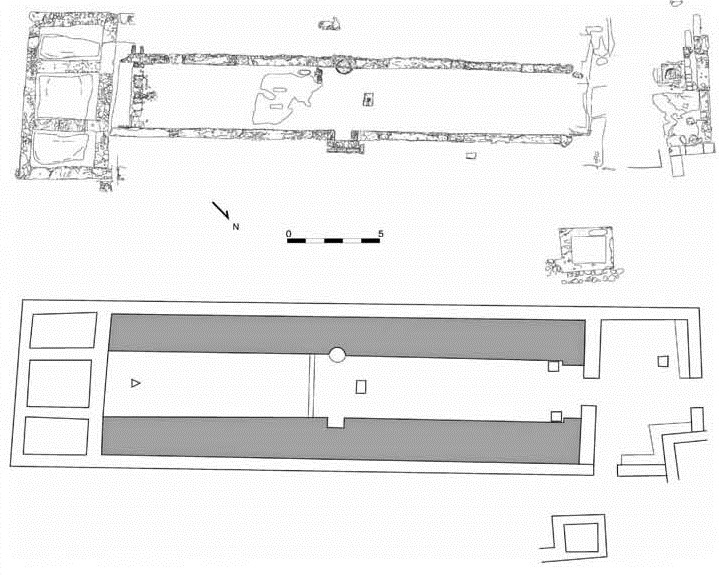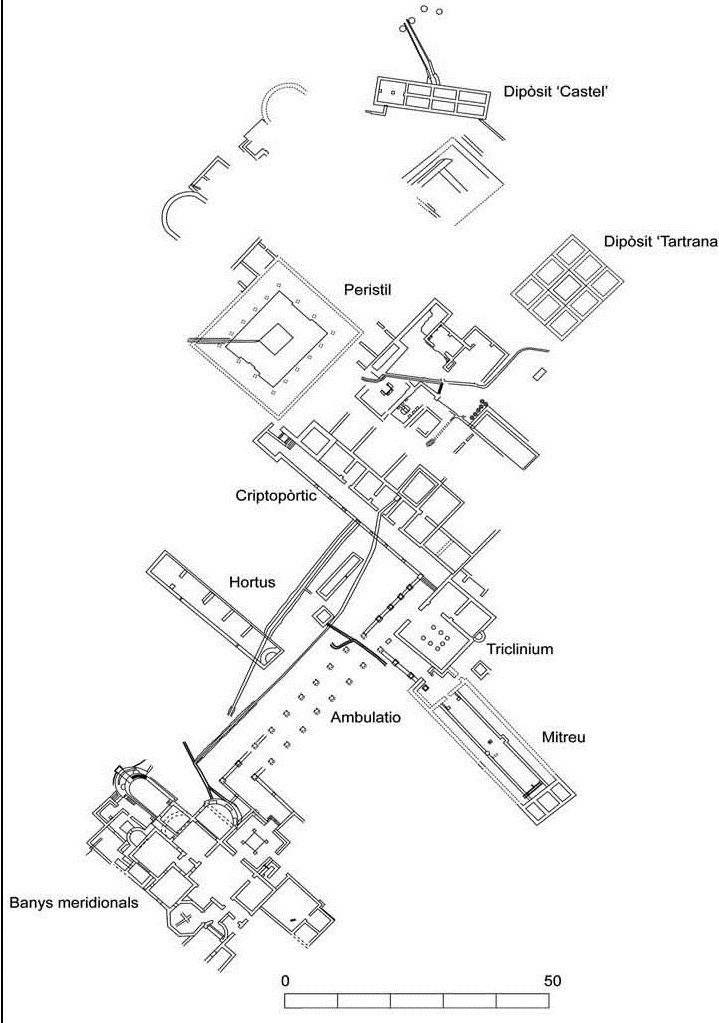
CIMRM Supplement - Mithraeum at the Villa of Els Munts, Altafulla, near Tarragona, Spain.
In 2004 a Mithraeum was discovered in the ruins of a large Roman villa-complex on a small hill near the beach, in the town of Altafulla, about 10km along the coast from Tarragona. The villa may have been a summer residence of the provincial governor.1 It was built in the 1st c. AD on a regular orthogonal plan, but the Mithraeum is on a slightly different orientation, evidently for some special astronomical or other reason. The Mithraeum was built after the start of the 2nd century. The villa complex was partly destroyed by fire around 275 AD, but the site remained in use on a reduced scale until the 7th century.
The Mithraeum is the largest currently known. The size of the main cella alone is L. 30 Br. 8.1 m. Among the finds are a triangular altar and two uninscribed altars. Fragments of sculpture were recovered in earlier campaigns.2
The area in which the mithraeum is located was already investigated by sample pits in the 70s, and in 1996. In order to resolve the issues raised and to verify the possible existence of a porticoed corridor, in 2004 an excavation was conducted which revealed most of a mithraeum, built in the early second century. Unfortunately, the destruction suffered by the building after its abandonment, and especially because of agricultural leveling in modern times, have led to the virtual disappearance of the perimeter walls, only recognizable, in some cases, from building trenches.
Initially, in the angle defined by the eastern section of the ambulatio and the southern facade of the triclinium, there is a portico about 12 m long, consisting of four pillars, with a width of 3.7 m and a intercolumnio ranging from 3-3.36 m. At the east end of the portico, a transverse wall was built with a door defining an irregular area (the pronaos of the mithraeum) which included the easternmost pillar. At a later time, the spaces between the remaining pillars of the portico and possibly access from the nearby ambulatio configuring the access corridor to the pronaos of the mithraeum.
The pronaos is a trapezoidal area of approximately 29 square metres. The irregularity of the plan is a result of the need to compensate for the deviation of the mithraic building in relation to the orthogonality that characterizes the villa built in the early second century. This deviation undoubtedly is linked to a particular site or astral position. This area that we identify as an antechamber of the mithraeum could have had several functions: a space for the gathering of followers (porticus), a dressing area (apparatorium) or a kitchen. The door in the northwestern wall is evidenced by a monolithic threshold - opening inward - which spanned the existing gap between the porch and the pronaos. Another possible door in the NE wall, lies outside the area so far investigated. A bench about 0.60 m wide runs along the better preserved northern wall. In the NW corner, sidewalk presents a marked deterioration related to a home whose fire also hit the wall of the triclinium. Only the initial pavement preparedness levels are preserved in the northern half. At a later time, around the first half / mid-third century, a new line of paving spread. Levels depreciation area could be located, despite the little material recovered at a later time in the mid-fourth century.
In the eastern wall of the pronaos, only evidenced by the trench spoliation, a door open, in a position possibly centered, that led to a corresponding to the grotto or spelaeum rectangular area, the bottom of which the classroom stood cult Meeting on podium (30 x 8.1 m, including classroom worship). Following the typical architectural model, either side two stools (or could Praesepia) of 26 meters long and just over two meters wide that define a central corridor of 3.6 / 3.7 m are arranged. Sidewalks are bounded by low walls of opus caementicium alternating with blocks of local stone (Mèdol / Welded) coated with a layer of opus signinum rojo8 painted with original height greater than 0.9 m. The inclusion of the blocks could be related to a hypothetical colonnades hold the central section of the roof and longitudinally segmental grotto in seven areas, a number of strong ideological charge in Mithraism (seven initiatory degrees). At the ends of the door closest to the indications sidewalks a small staircase allowing access to the top appreciated. Next to the southern sidewalk staircase she is located a ara anepígrafa and in the same position next to the northern curb the imprint of a second was identified. It is likely to raise the possibility that the altars were dedicated to Cautes and Cautopates, the dadóforos accompanying Mitra.
Averaging the cave, two joints are documented on the sidewalks. A quadrangular section, in the northern sidewalk and another semicircular section in the southern. The latter has a circular pavement opus signinum with a small perimeter enhancement and drain hole. These elements and the dense layer of calcareous concretion had preserved indicate that use hydraulic mitraico related ritual. In this regard, it should be noted that the space in which these elements are located - and coinciding approximately with a stone base with lace circle located on the axis of the corridor - would correspond, hypothetically, to the fourth degree (Leo), the first of the higher grades. A possible low wall, very deteriorated, delimit the eastern part of the fourth space and mark a hypothetical change in paving documented. Unfortunately, not conserved traces pavement and identified levels correspond to the base of the preparation, compacted clays half nearest access and mortar in which it extends from the fourth to the classroom space cult. The level of the floor is indicated by the lower end of liner sidewalks, between 10 and 20 cm above the preserved. We do not know if it could be related to a premeditated destruction or intense reuse of which we have not detected other possible indications.
The eastern end of the sidewalks is delivered to a perpendicular wall that enhances classroom tripartite cult. Deterioration is here too deep. They have detected the foundations of the walls close and constructive level waste consists of carving stone blocks Mèdol / Welded (local stone) that formed the elevation. At the foot of the altar hollow triangular podium, also in local stone, of which only the base and a pipe perpendicular to the longitudinal axis related to two holes at the points of contact with the boundary walls of the sidewalks remains are located.
As we have already pointed out, the building was devoid of the rich decorative and iconographic furniture that accompanies this type of cultic enclosure. In addition to the reasons cited - by the gateway to the cave at the foot of the classroom cult - and the base of a statuary element in the central area of the cave, all of them in situ, in the bottom of a recess in the levels of silting of the cave located approximately in the middle of it a piece of sculpture of complex identification and ara anepígrafa were located.
The mitreo is built after the initial project built in the early second century villa if we stick to irregular architectural fit between the southern portico of the triclinium and the building of worship. In the two surveys conducted in a very constructive levels eroded As (Claudio?), African ceramic kitchen, TS sudgálica and Hispanic and indeterminate common pottery recovered. A set very small and unrepresentative to chronological level.
With the final moment of use of the building we could relate the levels of silting of the channel at the foot of the podium cult classroom and two sinks. Among the recovered material, composed mainly of bone remains of birds, the presence of a coin of Alexander Severus (234 AD) which puts us in a post second quarter of the third century now. Finally, levels of landslide that gave the grotto amortized representative materials of the second half / late fourth century. It is worth noting the significant presence of pieces of sectile opus and fragments of plate of various marbles (African, Broccatello, Cipollino, Grecoscritto, Luni-Carrara, pavonazzetto, Stone Alcover, red porphyry, Portasanta, Rosso Antico Verde Antico, etc) whose relationship with this building can only hypothesize. Finally, various rasas of pillaging the perimeter walls that can put in the IV-V centuries from scarce archaeological material recovered were detected.
Mitra excerpt from the Munts Roman villa (ager Tarraconensis), Josep Anton Remolà Vallverdú. National Archaeological Museum of Tarragona
External references
- Josep Anton Remolà Vallverdú, Museu Nacional Arqueològic de Tarragona - Jornadas Mithraicas.
- Mithraeum.eu.
- Francesc Tarrats Bou, Josep Anton Remola Vallverdu &c, "La villa romana dels Munts (Altafulla, Tarragonès) i Tarraco", Academia.edu article.
| 1 | Ezquerra, l.c. |
| 2 | Jaime Alvar Ezquerra, Romanising Oriental Gods: Myth, Salvation, and Ethics in the Cults of Cybele, Isis, and Mithras, Brill, 2008, p.358. Google books preview here. |
| Tweet |





